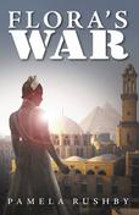Flora's War by Pamela Rushby

Ford St Publishing, 2013. ISBN: 9781921665981.
Highly recommended for readers aged 13+. Between April 25 1915 and
January 9 1916, the Battle of Gallipoli, also known as the
Dardanelles Campaign, raged between British/French Allies and the
crumbling Ottoman Empire in modern day Turkey. It was a defining
moment for both sides but for Australia and New Zealand, arguably
the most significant military episode in their respective histories,
giving rise to an enduring national identity and the concept of the
ANZAC spirit. Since then there have been countless books,
discussions, films, articles and other retellings both fact and
fiction, of the tragic casualties suffered - a shocking almost 30,
000 Australian soldiers dead or wounded as a result of combat.
Pamela Rushby has previously explored through fiction and
nonfiction, Australia's part in significant wars, Ancient and Modern
Egypt and archaeology and in this new novel, combines all of these
ingredients to present a very different slant on the ANZAC story.
Flora is a young girl, newly transitioned from schoolgirl to young
woman, the daughter of a well-known Australian archaeologist who
enjoys an annual sojourn in Cairo, helping her father with his
current dig. In 1915 however, Cairo is a very different city
from all her previous visits, with endless rows of army tents,
drilling troops and dedicated young nurses in abundance. Far
from Flora's anticipation of a whirl of social engagements as newly
emerged 'young lady', within a very short time Cairo is hurled into
the bloody Dardanelles Campaign aftermath as waves of wounded
soldiers are transported from the Gallipoli battle- many of them in
near-fatal condition. The normal structure of hospitals and
nursing staff cannot cope with this flood of piteous survivors and
every possible building is commandeered to accommodate those who
recover and volunteers are hard pressed to transport and nurse them.
Flora's account of the Gallipoli tragedy is told compassionately and
provides the reader with a little known side to the well known
history of this disastrous military venture. The personal
relationships woven throughout the story lend depth and emotion to
the characters and their situations and the reader is drawn into the
atmosphere of the dark days they endured. The author has used
extensive research to provide solid factual recounts of the events.
This novel would make an extremely valuable addition to any
secondary library as well as a significant contribution to the study
of World War 1 and Australian Identity (ACARA Year 9 History
Strand).
Sue Warren